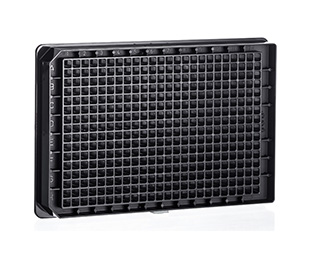CELLVIEW PLATES
Cell Culture Products for Microscopy
With its advantages for molecular selectivity and capability of live observation, fluorescence microscopy currently is among the most widely used approaches for high resolution, non-invasive imaging of living cells. Depending on the complexity of live cell imaging experiments and the requirements of the corresponding microscope, the requests for the utilised disposables can be as comprehensive. Greiner Bio One’s CELLview™ imaging consumables are tailored solutions to provide optimal basic settings for your microscopic experiment:
- Maximal light transmission for enhanced signal-to-noise ratio
- Innovative design for maximal planarity and stable focal plane
- Reduced meniscus effect due to optimised well design
- Proprietary surface technology for optimal cell attachment and viability
- Subdivided versions for multiplex analysis and comparability
- Elaborate features to reduce reagent consumption
- Sterile, non-pyrogenic, non-cytotoxic and free of detectable DNase, RNase and human DNA
CELLview products combine the convenience of a plastic disposable with the high optical quality of a 0.17 mm thin cover glass bottom, providing superior high-resolution microscopic images of in-vitro cultures. The specific design with the embedded cover glass bottom guarantees a single-plane, flat bottom with a consistent working distance, maximal planarity and optimal thermal conductivity in heated platforms. Glass bottom microplates feature excellent intra- and inter-well flatness due to the rigidity of the glass bottom. As microscope objectives are adapted to the bottom thickness and refractive index of cover glass, generally the best optical quality with highest resolution can be achieved using glass bottom disposables.
Glass bottom features:
- Highly transparent borosilicate glass; hydrolytic class 1 (DIN ISO 719)
- Glass thickness 0.17 mm
- Maximal spectral transmission; no autofluorescence
- Exceptional planarity
- Manufactured according to ISO 8255 – 1:1986 (Optics and optical instruments – Microscopes – Cover glasses)
Beside visual requirements, a glass bottom should also meet cell culture demands and facilitate successful cultivation of various cell types. Due to the general hydrophobicity of glass, only a minor proportion of cells can adhere to it. Therefore these cells are often only loosely attached, do not display their cell-specific morphology and can get lost during staining and washing steps. Furthermore live cell analysis of such ailing cells might not reveal their realistic in-vivo response. To guarantee optimal cell culture conditions during cultivation and microscopic analysis, the CELLview™ cell culture disposables are provided with two surfaces: Tissue culture treated (TC) for propagation of standard cell lines and Advanced TC surface facilitating in particular cultivation of sensitive and primary cells. The non-biological surface optimisation leads to consistent and homogenous cell attachment reducing cell loss during transfection or staining procedures making previously required protein coatings of glass surfaces dispensable.
SCREENSTAR microplates with a 0.19 mm cycloolefin film bottom are suitable for sophisticated microscopic applications, in high content screening (HCS) or high resolution microscopy with water and oil immersion objectives. Cycloolefins comprise a new class of polymeric materials with inherent physical properties of high glass transition temperature, optical clarity, low shrinkage, low moisture absorption, and low birefringence. Cycloolefins possess excellent optical features and display a low background in the lower UV, with a refractive index and focus background comparable to glass.

